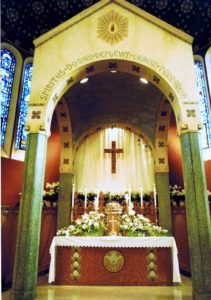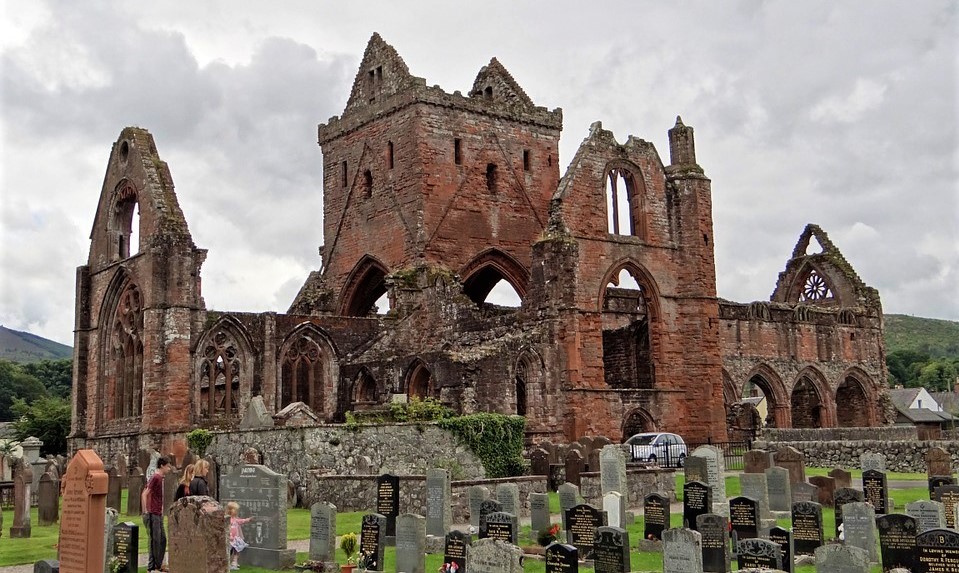 The week in the Office of Readings from the Liturgy of the Hours we are reading from the books of Haggai and Zechariah. Both these prophets wrote at the time of the return of the Jews from the Babylonian exile, which had begun in 587 B.C. The Jewish people were permitted to return to the Promised Land beginning in about 538 B.C. Haggai wrote his book in the summer of 520 B.C. and in it he scolds the people for concentrating on their “paneled houses” while the Temple is in a ruinous state. He ties their weak piety to the failure of crops, their inability to enjoy what they have, and other calamities.
The week in the Office of Readings from the Liturgy of the Hours we are reading from the books of Haggai and Zechariah. Both these prophets wrote at the time of the return of the Jews from the Babylonian exile, which had begun in 587 B.C. The Jewish people were permitted to return to the Promised Land beginning in about 538 B.C. Haggai wrote his book in the summer of 520 B.C. and in it he scolds the people for concentrating on their “paneled houses” while the Temple is in a ruinous state. He ties their weak piety to the failure of crops, their inability to enjoy what they have, and other calamities.
Zechariah, who wrote in the autumn of 520 B.C., also expresses concern for the poor state of the Temple and ties its rebuilding to future blessings, including the coming of the Messiah. Later in the week, we will examine Zechariah’s writing.
In today’s post we look at a passage from the Book of Haggai and ponder what it means for us:
This is what the LORD of Hosts says: “These people say, ‘The time has not yet come to rebuild the house of the LORD.’” Then the word of the LORD came through Haggai the prophet, saying: “Is it a time for you yourselves to live in your paneled houses, while this house lies in ruins?” Now this is what the LORD of Hosts says: “Think carefully about your ways. You have planted much but harvested little. You eat but never have enough. You drink but never have your fill. You put on clothes but never get warm. You earn wages to put into a bag pierced through.” You expected much, but behold, it amounted to little. And what you brought home, I blew away. Why? declares the LORD of Hosts. Because My house still lies in ruins, while each of you is busy with his own house (Haggai, 1:2ff).
God does not need a fancy temple, but we do. The building of beautiful churches says a lot about our priorities and where our heart lies. Churches express our love for God and our desire to honor and thank Him. They need not be extravagant, but they should be adorned with a beauty and form that stands out as sacred and memorable, as an expression that we love God and take Him seriously, that He is a priority in our lives. In the Middle Ages, the town church was usually centrally located and was the tallest and most prominent building. By the 16th century, palaces and government buildings began to take that place. Today, the skyscrapers of our cities are named for investment banks and insurance companies. Yes, our buildings say something about our priorities!
 Churches are also meant to remind us of Heaven. Until recent decades, they were built along lines that spoke to the heavenly realities both Moses and John saw as they were shown the heavenly worship and vision. Churches have high jeweled (stained glass) walls because Heaven does. Churches have glorious throne-like altars with the tabernacle at the center amidst tall candles because in Heaven there is a throne-like altar with the Lamb upon it and Jesus stands among the lampstands. Paintings and statues of saints and angels, incense, priestly robes, standing/kneeling appropriately, and singing of hymns all remind us of the communion of saints and angels in the heavenly worship. All of this is revealed in the heavenly visions contained in the Bible. (I have written more on this topic here and here.)
Churches are also meant to remind us of Heaven. Until recent decades, they were built along lines that spoke to the heavenly realities both Moses and John saw as they were shown the heavenly worship and vision. Churches have high jeweled (stained glass) walls because Heaven does. Churches have glorious throne-like altars with the tabernacle at the center amidst tall candles because in Heaven there is a throne-like altar with the Lamb upon it and Jesus stands among the lampstands. Paintings and statues of saints and angels, incense, priestly robes, standing/kneeling appropriately, and singing of hymns all remind us of the communion of saints and angels in the heavenly worship. All of this is revealed in the heavenly visions contained in the Bible. (I have written more on this topic here and here.)
Haggai’s opening vision also says a lot about our inability to enjoy even the good things we have without God at the center. We all have a God-sized hole in our heart and only He can ultimately fill it. Trying to get created things to fill that gap is both frustrating and futile. The good things we do have point to God, the giver, and should inspire in us a gratitude and longing for Him. If we remove or marginalize God, our disorder affections gnaw away at us; no matter how much we get we remain dissatisfied.
God says through Haggai that fixing the ruined Temple is the way to fix their hearts. It is less about the building than about hearts. It is interesting that some of the most glorious and beautiful churches in this country were built by poor immigrant communities. We now live in times of comparative affluence, especially in America, but although incomes and home sizes have grown our churches seem to be built on the cheap, lacking both the nobility and glory that belong to God and which poorer generations produced in the churches of their time.
The problem has both theological and liturgical roots. A flawed notion of the liturgy claimed that churches should look more like living rooms or dining rooms than Heaven. (N.B. Some more recently built churches are returning to more traditional forms, but the reform has been slow).
Another problem was/is the “poverty of Judas.” This is the idea that money spent on buildings would be better used by being given to the poor. There may be a little truth to that, but the poor also want and need beautiful churches that remind them of Heaven and give due honor to God. A church is a space of beauty that all can share.
Yet another reason is that we just don’t value or prioritize the Lord and the liturgy as highly anymore. If we give less to the church perhaps we can buy a nicer car, a boat, or a vacation home. How is that ephemeral stuff working out for us? Are we happier? Haggai says no: You eat but never have enough. You drink but never have your fill. Exactly! All our blessing point to God and should instill gratitude and a longing for the true completion of an eternal relationship with Him.
Enough said for now. The point is not so much a building itself but what the building says about our hearts. God says today through Haggai, in effect, “Your paneled houses and the ruined Temple are a testimony to the condition of your hearts and your flawed priorities.”
Indeed, God should get the first fruits of our harvest, our best and highest effort. This is not because he needs them but because we do.


So many temples given to glorify the Most High, the Garden, not enough, the Body and Soul, not enough, the worship, not enough, the law, the prophets, the angels, the signs, the miracles, not enough, the promise land, not enough, chosen of nations, not enough, Body of Christ, not enough, Savior and
Redeemer, not enough, Bread of Life, not enough, The Church from on High, not enough, the Good News, not enough, the promise, the resurrection, the glory, the redemption, not enough, creation, paradise, life eternal, heaven on earth, not enough, it will never be enough for some, never, all good should be pursued, all glory to the Most High, but without a detachment from everything for the love of God will we survive and thrive in his service and not be weigh down with all the endless possibilities that we harbor in our minds to be dissatisfy with everything.
“The building of beautiful churches says a lot about our priorities and where our heart lies. Churches express our love for God and our desire to honour and thank Him.”
UMM!? REALLY? I sincerely hope and pray that is the case. Excellent, if it is!
It can also, of course, ‘express our pride and arrogance’ in our belief that we are better than the next parish or cathedral and that God will favour us more if we build a bigger, better and prettier edifice for Him . . . !! And – it can also make us forget our responsibilities to others elsewhere who are in need of a basic meal to eat or simple room to live in!
Here’s a small, but true, story: I recall back in 2004, at St John’s Cathedral here in Portsmouth, UK, that we were to be given the very ancient statue of our Lady that stood for almost 100 years in my old seminary in London, when it closed down, to place at The Lady Chapel in the Cathedral. It was indeed very old – and chipped and scratched – and needed a great deal of restoration.
There was an estimate that the work needed would cost around £350 (approx. $460 USA).
I thought this was a worthwhile exercise, as it would not only honour the memory of Our Gracious Lady, Mother of God, but it would honour also the old seminary – from which, by the way, I never did finally exit as an ordained priest – but that’s another story!
I, therefore, offered to cover the cost of the restoration – on one condition! That the entire diocese (not just the Cathedral Parish) would agree in turn to make a donation of exactly the same amount to local homeless charities.
To say the least, this was NOT viewed at all sympathetically!! Oh my, no!! And I was told basically, “Forget it!” So I did!!
The statue was indeed eventually restored (presumably paid for by someone else or out of Cathedral funds) and placed at the Lady Chapel in the Cathedral – but there has never been any record of any similar sum being donated to local homeless charities. I hope in all humility that I make myself perfectly clear and that all reading this blog, and my response will work out for him/herself the point I am trying in all charity to make.
By all means, let’s have beautiful churches and other religious buildings – as long as we get the rest of it right!
God bless all . . . . .
Donation should be unconditional. Otherwise it is barter.
Could the same be said about the music of the Mass? For example, by replacing “building” where used with music?
People who really know beauty build beautiful things, promote beauty and strive to live lives of beauty. Which is to say, lives of truth, goodness and beauty. There is no dichotomy between beauty and charity. As Saint Teresa of Calcutta reminded us, to serve the poorest of the poor is to do something beautiful for God. The poor, especially the spiritual poor, need beauty in their lives. Beautiful churches challenge the stunting utility of contemporary “values” that reduce people to their mere use or “basic” needs. Beauty which is good and true offers hope to others, and that hope is a promise of being loved by God. A heart that knows such love is one that expresses itself in beauty and goodness. Hospitals and schools come from hearts of love moved by the beauty of redemption in Christ.